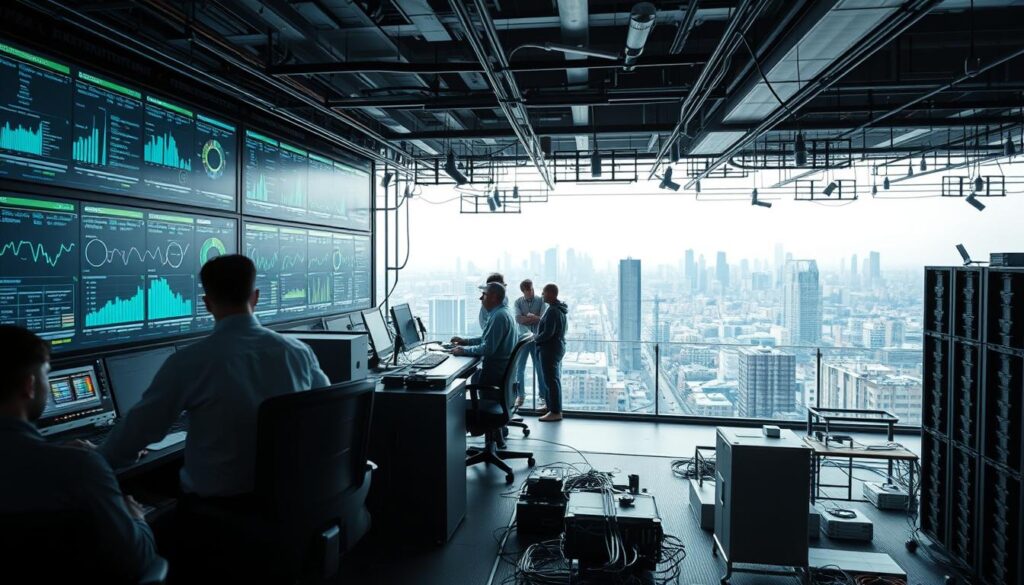A significant 30% increase in operational efficiency is experienced by organizations using more than one cloud service, highlighting the importance of effective collaboration and strategic integration in today’s fast-paced technological landscape.
As organizations strive to enhance efficiency, agility, and innovation, optimizing engineering and policy collaboration becomes crucial. By fostering a culture of collaboration and innovation, organizations can achieve successful project outcomes.
Effective collaboration between engineering and policy disciplines is key to driving innovation and achieving project success. With a well-integrated approach, organizations can reap numerous benefits, including improved efficiency and reduced costs.
Key Takeaways
- Optimizing collaboration enhances operational efficiency.
- A well-integrated approach drives innovation and project success.
- Effective policy and engineering collaboration reduces costs.
- Strategic integration is crucial in today’s technological landscape.
- Organizations using multiple cloud services see a significant increase in efficiency.
Understanding the Importance of Integration
Understanding the importance of integrating engineering and policy is vital for fostering a collaborative environment that promotes sustainable development. Effective integration ensures that engineering projects are not only technically sound but also align with policy objectives, leading to more cohesive and effective outcomes.
The Role of Engineering in Policy Development
Engineering plays a pivotal role in policy development by providing the technical expertise necessary to inform and shape policy decisions. In areas such as urban planning, engineers can offer insights into the feasibility and potential impacts of different policy initiatives, helping policymakers to make more informed decisions.
University-industry collaboration is essential for creating robust talent cultivation models that can bridge the gap between engineering practices and policy needs. By working together, engineers and policymakers can develop more effective solutions to complex challenges.
Why Policy Matters in Engineering Decisions
Policy matters significantly in engineering decisions as it provides the regulatory framework within which engineering projects are conceived and executed. Policies related to sustainable development can influence the choice of materials, technologies, and methodologies used in engineering projects, ensuring that they contribute to broader environmental and social objectives.
By understanding and integrating policy considerations, engineers can ensure that their projects are not only compliant with current regulations but also aligned with future policy directions, thereby enhancing their long-term viability and impact.
Key Challenges in Engineering and Policy Integration

Despite the benefits of combining engineering and policy, several obstacles hinder effective collaboration. Effective cross-departmental collaboration is crucial for the success of engineering projects. However, the integration of engineering and policy is often challenged by various factors.
Communication barriers between disciplines are a significant hurdle. Engineers and policymakers often speak different languages, making it difficult to understand each other’s needs and constraints. For instance, engineers might focus on the technical feasibility of a project, while policymakers are concerned with the regulatory and social implications. Bridging this gap requires a concerted effort to establish a common language and understanding.
Communication Barriers Between Disciplines
The difference in terminology and methodologies between engineers and policymakers can lead to misunderstandings. Engineers often rely on data and technical specifications, whereas policymakers are influenced by political, social, and economic factors. To overcome this, it’s essential to foster an environment where both sides can communicate effectively.
Regular interdisciplinary meetings and workshops can help in aligning the goals and understanding of both engineers and policymakers. By doing so, they can work together more effectively, ensuring that projects are both technically sound and compliant with regulatory requirements.
Regulatory Constraints Impacting Engineering
Government regulations play a crucial role in shaping engineering projects. While these regulations are essential for ensuring safety and compliance, they can sometimes constrain innovation and delay project timelines. Understanding and navigating these regulations is vital for successful project execution.
Engineers must be aware of the regulatory landscape and work closely with policymakers to ensure that their projects meet all necessary requirements. This collaboration can help in identifying potential regulatory issues early on, thereby reducing the risk of costly delays or project cancellations.
- Staying updated with the latest government regulations
- Engaging with policymakers throughout the project lifecycle
- Incorporating regulatory compliance into project planning
By addressing these challenges and working together, engineers and policymakers can achieve more effective and sustainable outcomes.
Best Practices for Effective Collaboration
To achieve seamless integration of engineering and policy, adopting best practices is essential. Effective collaboration between engineers and policymakers can lead to more sustainable and environmentally conscious projects, partly through the use of environmental impact assessments.
Establishing Multidisciplinary Teams
One of the key strategies for enhancing collaboration is the establishment of multidisciplinary teams. By bringing together professionals from various backgrounds, including engineering, policy, and environmental science, organizations can foster a more holistic understanding of projects. This approach helps in identifying potential environmental impacts early on, allowing for more effective mitigation strategies.
Multidisciplinary teams can break down knowledge silos and promote cross-functional collaboration. For instance, involving environmental scientists in the early stages of engineering projects can ensure that environmental impact assessments are thorough and inform project decisions.
Utilizing Collaborative Technologies
The use of collaborative technologies is another best practice that can significantly enhance the integration of engineering and policy. Tools such as project management software, collaborative document editing platforms, and virtual meeting technologies can facilitate communication and coordination among team members.
By leveraging these technologies, teams can work more efficiently, share information in real-time, and make more informed decisions. For example, collaborative project management tools can help track the progress of environmental impact assessments and ensure that all stakeholders are informed and aligned.
The Role of Stakeholders in Integration

Stakeholders play a pivotal role in shaping the outcome of engineering projects, particularly in infrastructure management. Their involvement is crucial for ensuring that projects meet the needs of the community, comply with regulatory requirements, and are executed efficiently.
Identifying Key Stakeholders in Engineering
Identifying key stakeholders is the first step towards effective integration. In engineering projects, stakeholders can include government agencies, local communities, contractors, and project investors. Each of these stakeholders brings unique perspectives and requirements to the table.
For instance, government agencies are responsible for ensuring that projects comply with existing regulations and standards. Local communities, on the other hand, are concerned with how the project affects their environment and quality of life.
Engaging Policymakers in Engineering Projects
Engaging policymakers is a critical aspect of integrating engineering and policy. Policymakers can provide valuable insights into regulatory requirements and can help in aligning project goals with policy objectives.
Effective engagement involves regular communication, collaborative planning, and sometimes, involving policymakers in key decision-making processes. This not only ensures that projects are compliant with policy but also fosters a sense of ownership among policymakers, which can be beneficial for project success.
By understanding the needs and concerns of all stakeholders, engineers can design projects that are not only technically sound but also socially and politically viable.
Case Studies of Successful Integration
Through the lens of public policy analysis, case studies of successful integration offer practical lessons for engineers and policymakers alike. By examining real-world examples, we can gain a deeper understanding of how to effectively collaborate across disciplines.
Successful Engineering-Policy Partnerships
Several case studies highlight the benefits of successful partnerships between engineers and policymakers. For instance, a study on university-industry collaborations found that joint research projects led to significant advancements in both fields as reported in a research paper.
One notable example is the collaboration between a city’s transportation department and local engineering firms to improve infrastructure. This partnership resulted in more efficient project delivery and better alignment with city policies.
“The integration of engineering and policy is not just beneficial; it’s essential for achieving sustainable and effective solutions.”
Lessons Learned from Integrated Projects
Analyzing successful integrated projects reveals several key lessons. These include the importance of clear communication, the need for flexible regulatory frameworks, and the value of stakeholder engagement.
| Lesson Learned | Description |
|---|---|
| Clear Communication | Ensuring that all stakeholders understand project goals and constraints is crucial. |
| Flexible Regulatory Frameworks | Adaptable policies can facilitate smoother project execution. |
| Stakeholder Engagement | Engaging with stakeholders early and often can prevent misunderstandings and improve outcomes. |
By applying these lessons, future projects can benefit from the experiences of successful integrations, ultimately leading to better collaboration between engineers and policymakers.
Tools and Resources for Engineers and Policymakers

The right tools and resources are essential for facilitating effective collaboration between engineers and policymakers. By leveraging these tools, stakeholders can enhance their engagement and work together more efficiently.
Software Solutions for Enhanced Collaboration
Several software solutions can facilitate collaboration between engineers and policymakers. These include:
- Project Management Tools: Tools like Asana, Trello, and MS Project help in managing tasks and tracking progress.
- Collaboration Platforms: Platforms such as Slack and Microsoft Teams enable real-time communication and information sharing.
- Data Analytics Software: Tools like Tableau and Power BI help in analyzing data and making informed decisions.
Essential Guides and Frameworks
In addition to software solutions, various guides and frameworks can support effective collaboration. These include:
| Guide/Framework | Description | Application |
|---|---|---|
| PMBOK Guide | A guide to project management standards | Project Management |
| Stakeholder Engagement Framework | A framework for engaging stakeholders effectively | Stakeholder Engagement |
| Policy Implementation Guide | A guide for implementing policies effectively | Policy Implementation |
By utilizing these tools and resources, engineers and policymakers can enhance their collaboration and achieve successful project outcomes. Effective stakeholder engagement is critical to this process, ensuring that all parties are aligned and working towards common goals.
Training and Education for Integrated Approaches
Effective integration of engineering and policy requires a multifaceted approach to education and training. As we move towards a more interconnected world, the need for professionals who can bridge the gap between these two disciplines becomes increasingly important.
Incorporating Integration into Engineering Curricula
Engineering programs are now incorporating coursework that focuses on policy and regulatory issues, preparing the next generation of engineers to work effectively with policymakers. This includes hands-on training in technology integration, where students learn to apply technological solutions to real-world policy challenges.
“The future belongs to those who understand the intersection of technology and policy, and who can navigate the complexities of both worlds.”
By integrating policy-making into engineering curricula, educational institutions can foster a new breed of professionals who are adept at navigating both the technical and regulatory landscapes.
Policymaking Workshops for Engineers
Policymaking workshops designed specifically for engineers offer a unique opportunity for professionals to gain insights into the policy-making process. These workshops focus on practical skills such as data analysis, stakeholder engagement, and effective communication. By understanding how policy decisions are made, engineers can better align their work with the needs of policymakers, facilitating smoother integration.
- Understanding the policy-making process
- Developing data analysis skills for policy decisions
- Enhancing stakeholder engagement strategies
Through such educational initiatives, engineers can become more effective partners in the policy-making process, driving towards more integrated and effective solutions.
The Future of Engineering and Policy Integration

Staying ahead of emerging trends in engineering and policy is essential for future success in urban planning. As cities continue to grow and evolve, the integration of engineering practices and policy decisions will play a crucial role in shaping sustainable and efficient infrastructures.
Emerging Trends in Engineering Practices
The field of engineering is rapidly advancing, with several emerging trends set to impact urban planning significantly. Some of these trends include:
- Increased Use of Technology: The adoption of technologies like AI, IoT, and blockchain is transforming engineering practices, enabling more precise and efficient project execution.
- Sustainable Materials: The development and use of sustainable materials are becoming more prevalent, reducing the environmental footprint of engineering projects.
- Resilience and Adaptability: Engineers are now focusing on creating infrastructures that are resilient to climate change and adaptable to future needs.
Anticipating Policy Changes for Better Alignment
Anticipating policy changes is crucial for better alignment between engineering practices and regulatory frameworks. Policymakers are increasingly recognizing the importance of integrating engineering insights into policy decisions. Some anticipated policy changes include:
- Stricter Environmental Regulations: Policies are expected to become more stringent to address environmental concerns, impacting how engineering projects are designed and executed.
- Increased Funding for Sustainable Projects: Governments are likely to allocate more funds to projects that prioritize sustainability and environmental stewardship.
- Enhanced Collaboration Mechanisms: Policies may be introduced to facilitate better collaboration between engineers, policymakers, and other stakeholders.
By staying informed about these emerging trends and anticipated policy changes, professionals in both engineering and policy can work together more effectively to create better urban planning outcomes.
Environmental Considerations in Integration
Environmental considerations are now at the forefront of engineering and policy decisions. As the world grapples with climate change, pollution, and biodiversity loss, the need for sustainable practices in engineering has become more pressing than ever.
The integration of environmental policy in engineering is crucial for achieving sustainable development. By aligning engineering practices with environmental policies, we can ensure that infrastructure projects and technological advancements do not harm the environment. For instance, engineering projects that adhere to strict environmental standards can significantly reduce their ecological footprint.
The Role of Environmental Policy in Engineering
Environmental policy plays a pivotal role in shaping engineering practices. Government regulations set the framework within which engineers must operate, ensuring that projects are designed and implemented with environmental sustainability in mind. These regulations can include standards for emissions, waste management, and resource utilization.
For example, policies that promote the use of renewable energy sources are driving innovation in engineering, leading to more sustainable infrastructure. By complying with these policies, engineers can contribute to reducing the environmental impact of their projects.
Sustainable Development Goals and Engineering
The Sustainable Development Goals (SDGs) provide a global framework for achieving a more sustainable future. Engineers play a critical role in achieving these goals, particularly in areas such as clean water, affordable and clean energy, and climate action.
By aligning their work with the SDGs, engineers can ensure that their projects contribute to broader sustainability objectives. This alignment not only benefits the environment but also enhances the social and economic viability of engineering projects.
| SDG | Engineering Contribution | Environmental Impact |
|---|---|---|
| Clean Water and Sanitation | Designing water treatment plants and distribution systems | Improved water quality and reduced pollution |
| Affordable and Clean Energy | Developing renewable energy technologies and grids | Reduced greenhouse gas emissions |
| Climate Action | Implementing climate-resilient infrastructure and disaster response systems | Enhanced resilience to climate change impacts |
In conclusion, environmental considerations are integral to the integration of engineering and policy. By understanding the role of environmental policy and aligning with sustainable development goals, engineers can create more sustainable and environmentally friendly projects.
Measuring the Impact of Integration Efforts

To gauge the success of integrated approaches, it’s essential to measure their impact on environmental and infrastructure outcomes. Effective integration can lead to more sustainable and resilient infrastructure, ultimately benefiting both the environment and the communities served.
Key Performance Indicators for Integration Success
Key performance indicators (KPIs) play a crucial role in assessing the success of integration efforts. For environmental impact assessment, KPIs might include metrics on greenhouse gas emissions reduction, water quality improvement, and waste reduction. In infrastructure management, KPIs could focus on project delivery timelines, budget adherence, and user satisfaction.
According to a study on policy integration, effective KPIs are those that are clearly defined, measurable, and aligned with overall project goals as discussed in this Cambridge publication.
Evaluating Project Outcomes
Evaluating project outcomes is a critical step in understanding the impact of integration efforts. This involves assessing whether the project has met its intended objectives, such as improving environmental sustainability or enhancing infrastructure resilience. It’s also important to identify any lessons learned and areas for improvement for future projects.
By using a combination of quantitative and qualitative evaluation methods, organizations can gain a comprehensive understanding of their project’s outcomes and the effectiveness of their integration efforts.
The Role of Technology in Integration
Effective collaboration between engineering and policy is now more achievable than ever, thanks to technology. Technology plays a vital role in enhancing collaboration and decision-making between these two disciplines.
The use of advanced technologies has transformed the way engineers and policymakers work together. By leveraging these technologies, they can make more informed decisions and create more effective policies.
Leveraging Data Analytics for Policy Decisions
Data analytics is a powerful tool that can be used to inform policy decisions. By analyzing large datasets, policymakers can gain insights into trends and patterns that can help shape policy. For instance, data analytics can be used to analyze the impact of existing policies, identify areas for improvement, and predict the outcomes of new policies. A study on data-driven policy making highlights its potential in enhancing public policy analysis and stakeholder engagement.
Utilizing Simulation Tools in Engineering
Simulation tools are another crucial technology used in engineering. These tools allow engineers to model complex systems, test hypotheses, and predict outcomes without the need for physical prototypes. This not only saves time and resources but also enables engineers to explore a wider range of scenarios, leading to more innovative solutions. By utilizing simulation tools, engineers can better understand the implications of their designs and make more informed decisions.
The integration of data analytics and simulation tools is revolutionizing the way engineering and policy collaborate. By embracing these technologies, we can create more effective policies and engineering solutions that benefit society as a whole.
Ethical Considerations in Engineering and Policy

Ethical considerations play a crucial role in the successful integration of engineering and policy. As technology integration advances, the need for ethical awareness in both fields becomes increasingly important.
The integration of engineering and policy is not just about achieving project goals, but also about ensuring that these goals are met in an ethical manner. This involves addressing complex ethical dilemmas that arise during engineering projects.
Addressing Ethical Dilemmas in Engineering Projects
Engineering projects often involve making difficult decisions that have ethical implications. For instance, decisions about resource allocation, environmental impact, and stakeholder engagement can all raise ethical concerns. To address these dilemmas, engineers must consider the potential consequences of their actions and strive to make decisions that are fair, transparent, and respectful of all stakeholders.
One approach to addressing ethical dilemmas is to establish clear guidelines and protocols for decision-making. This can involve developing ethical frameworks that provide a structured approach to resolving ethical issues. For more information on ethics in engineering, visit https://online.hbs.edu/blog/post/ethics-in-engineering.
The Importance of Transparency in Policy-Making
Transparency is essential in policy-making to ensure that decisions are made in the best interests of all stakeholders. When policymakers are transparent about their decision-making processes, it builds trust and credibility. This is particularly important in the context of engineering and policy integration, where complex technical information must be communicated to non-technical stakeholders.
To promote transparency, policymakers can use various tools and techniques, such as public consultations, stakeholder engagement, and clear communication of policy rationales. By doing so, they can ensure that their decisions are informed by a wide range of perspectives and that the public is confident in the integrity of the policy-making process.
Building a Culture of Integration
To achieve lasting integration, it’s essential to develop an organizational culture that values collaboration across disciplines. This involves creating an environment where engineers and policymakers can work together seamlessly, driving projects that are both technically sound and policy-compliant.
Promoting Collaboration at All Organizational Levels
Promoting collaboration requires a top-down approach, starting with leadership that prioritizes integration. Multidisciplinary teams should be established to tackle complex projects, ensuring that diverse perspectives are represented. For instance, in urban planning, collaboration between engineers, policymakers, and community stakeholders is crucial for developing sustainable and livable cities.
Training programs and workshops can also facilitate collaboration by teaching engineers and policymakers to communicate effectively and understand each other’s challenges. For more insights on green engineering and policy integration, visit Number Analytics Blog.
Recognizing and Rewarding Integrated Efforts
Recognizing and rewarding efforts that embody integrated practices is vital for reinforcing the desired culture. Organizations should establish recognition programs that celebrate successful collaborations, whether through awards, bonuses, or public acknowledgment. This not only motivates individuals but also sets a precedent for the importance of integrated work.
In the context of sustainable development, recognizing integrated efforts can lead to innovative solutions that balance economic, social, and environmental objectives. By fostering a culture that values and rewards collaboration, organizations can drive meaningful progress in complex areas like urban planning.
The Impact of Global Perspectives on Integration

Understanding global best practices is essential for effective integration. As the world becomes increasingly interconnected, the importance of adopting a global perspective in engineering and policy integration cannot be overstated.
The value of international experiences lies in their ability to provide diverse solutions to complex problems. By examining how different countries approach integration, we can identify innovative strategies that might be adapted to our local contexts.
Learning from International Best Practices
Countries around the world have developed unique approaches to integrating engineering and policy, often driven by government regulations. For instance, the European Union’s stringent environmental regulations have led to the development of cutting-edge sustainable technologies.
- Denmark’s wind energy policies have made it a global leader in renewable energy.
- Singapore’s urban planning strategies have optimized public transportation and green spaces.
- The United States has a robust system for environmental impact assessment, ensuring that large infrastructure projects are thoroughly vetted for environmental consequences.
These international best practices offer valuable lessons that can be applied to enhance integration efforts elsewhere.
Adapting Lessons for Local Contexts
While international best practices provide a foundation, it’s crucial to adapt these lessons to fit local contexts. This involves understanding the specific government regulations and cultural nuances of the region.
“The key to successful integration lies not in mimicking international practices but in adapting them to suit local needs and regulatory frameworks.”
For example, a city might adopt a version of another country’s environmental impact assessment process, tailoring it to its own environmental concerns and legal requirements.
- Conduct a thorough review of local regulations and policies.
- Engage with stakeholders to understand community needs and concerns.
- Implement pilot projects to test adapted international best practices.
By combining global insights with local expertise, we can create more effective and sustainable integration strategies.
Conclusion: Moving Forward with Integration
Effective integration is a continuous process that requires ongoing effort and commitment. As we move forward, it’s essential to recognize that the collaboration between engineering and policy is crucial for creating resilient systems, such as those discussed in the context of complex systems of systems design found in recent studies.
Enhancing Collaboration through Infrastructure Management
Infrastructure management plays a vital role in facilitating the integration of engineering and policy. By leveraging technology integration and public policy analysis, stakeholders can make informed decisions that drive successful project outcomes. This, in turn, fosters an environment conducive to stakeholder engagement.
Future Directions for Engineering and Policy Integration
As we look to the future, it’s clear that the path to enhanced collaboration involves embracing innovative solutions and best practices in technology integration and infrastructure management. By doing so, we can create a more sustainable and efficient framework for engineering and policy integration.
